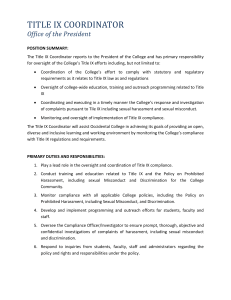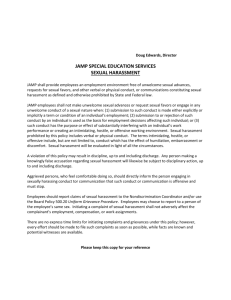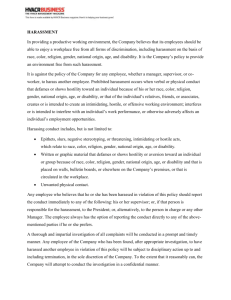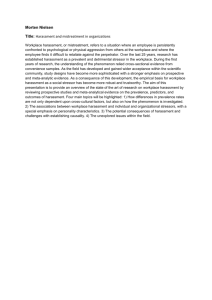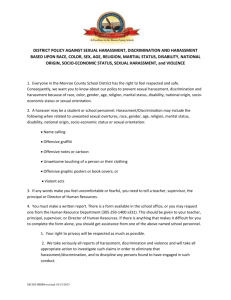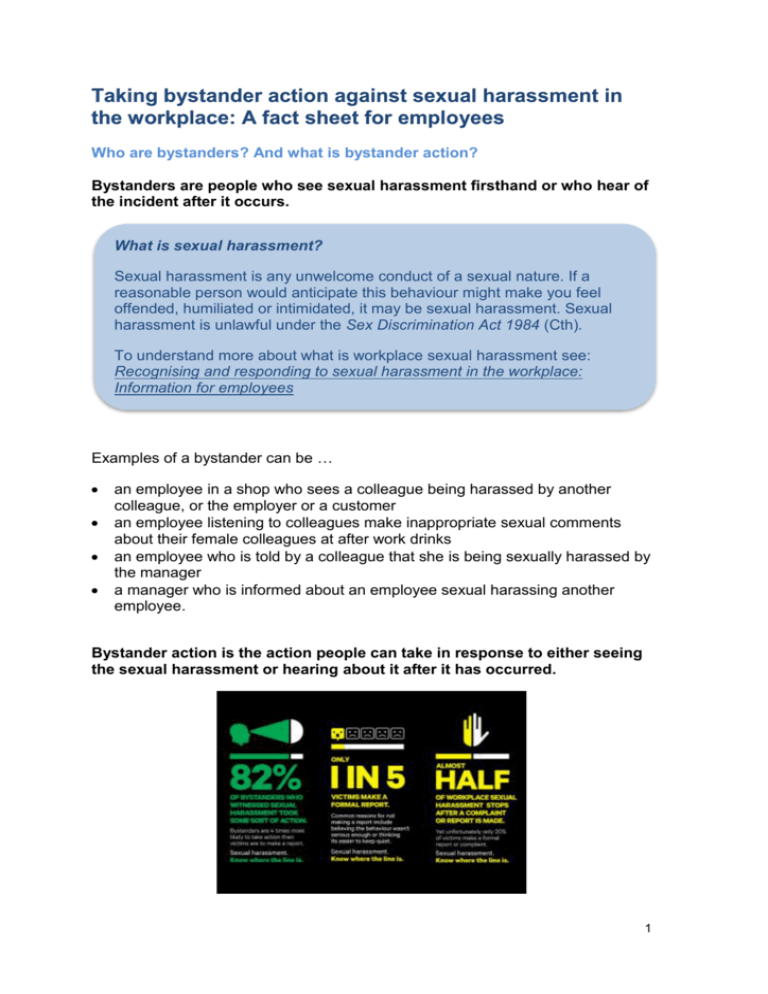
Taking bystander action against sexual harassment in
the workplace: A fact sheet for employees
Who are bystanders? And what is bystander action?
Bystanders are people who see sexual harassment firsthand or who hear of
the incident after it occurs.
What is sexual harassment?
Sexual harassment is any unwelcome conduct of a sexual nature. If a
reasonable person would anticipate this behaviour might make you feel
offended, humiliated or intimidated, it may be sexual harassment. Sexual
harassment is unlawful under the Sex Discrimination Act 1984 (Cth).
To understand more about what is workplace sexual harassment see:
Recognising and responding to sexual harassment in the workplace:
Information for employees
Examples of a bystander can be …
an employee in a shop who sees a colleague being harassed by another
colleague, or the employer or a customer
an employee listening to colleagues make inappropriate sexual comments
about their female colleagues at after work drinks
an employee who is told by a colleague that she is being sexually harassed by
the manager
a manager who is informed about an employee sexual harassing another
employee.
Bystander action is the action people can take in response to either seeing
the sexual harassment or hearing about it after it has occurred.
1
Why is bystander action important?
Fewer than one in six respondents to the Australian Human Rights
Commission 2012 Sexual Harassment Survey, who reported sexual
harassment, had formally reported the incident - either because they were
fearful that reporting would have a negative impact or they felt that the
response would be inadequate.
Because so few people report their experiences of sexual harassment,
bystanders have a powerful role to play in calling out behaviour that
crosses the line and supporting colleagues who experience sexual
harassment.
It takes courage to speak up but don’t underestimate the positive impact
that calling out workplace sexual harassment can have, not only on the
person being harassed but on your colleagues and the culture of your
organisation.
How can bystanders take action on workplace sexual harassment?
You can take bystander action if you witness sexual harassment at work. You can
also take action if you didn’t see the sexual harassment occur but someone told
you that it happened. The action you take may be different but both forms of
action can be effective.
You can see harassment when it occurs – recognise the behaviour for
what it is, name it, and do not ignore it
You can talk – to the person who is doing the harassment, telling him/her
to stop the harassment
You can also, with the permission of the person experiencing the
harassment …
- speak to your employer
- speak to your human resources manager
2
- speak to your colleagues.
You can support the person experiencing the harassment – you can help
them take action for themselves. You can support them by:
- listening to them
- referring them to your organisation’s policies and procedures about
sexual harassment
- assisting them find information about how to make a complaint
- encouraging them to report the problem
- offering to accompany them when they report the problem.
There are also other things you can do:
- talk to your manager or Human Resources about organising sexual
harassment training for the workplace
- talk to your manager or Human Resources about developing and
implementing sexual harassment policies and displaying them in a
prominent place
- talk to a union delegate or union about raising awareness of sexual
harassment in the workplace.
What bystander action is possible will differ in different workplace contexts, so it
may be necessary to adapt what action you take to the context of your workplace.
What about the risk of victimisation?
People who experience sexual harassment and bystanders can both be subject
to victimisation.
Victimisation involves retaliatory action, or the threat of such action, against a
person because they made a complaint of sexual harassment or because they
took bystander action in support of a complaint.
There are specific provisions in the Sex Discrimination Act that prohibit
victimisation in some circumstances.
A person could be victimised by the harasser themselves, or by co-workers who
support the harasser, especially if either of these parties are in more senior
organisational positions or have power over the person being victimised.
Examples of victimisation could be:
terminating a person’s employment
not giving a person a promotion
sidelining a person
singling out a person
some other form of detrimental behaviour towards a person
3
… because they took some sort of bystander action in response to sexual
harassment in the workplace (i.e. spoke up about it, reported it etc.).
Organisations which encourage bystanders to be proactive in responding to
sexual harassment should recognise the risk of victimisation and expressly
communicate to employees that bystanders will be protected from victimisation
and undertake disciplinary measures if victimisation does occur.
What can employers/workplaces do to encourage bystander action?
Bystander action in workplaces is more likely to be successful when:
there is strong leadership demonstrating a zero tolerance for sexual
harassment
bystanders know how to take action
bystanders have confidence if a person is found to have sexually harassed
another person, action will be taken against the harasser
bystanders have confidence they will be supported by their colleagues and
their organisation and will not be victimized for taking action
the organisation actively promotes gender equality and respectful
relationships.
Employers/ workplaces can encourage bystander action by:
Developing policies and guidelines for bystander action on sexual
harassment.
Providing education and training about bystander action: This can teach
people how to safely and effectively intervene in incidents and challenge
sexual harassment.
Creating a workplace environment that encourages reporting of sexual
harassment:
– encouraging leaders to speak out positively about taking bystander
action
– providing multiple communication channels to report sexual
harassment
– responding to reports of sexual harassment in a timely way
– providing training for those responsible for acting on reports of
sexual harassment.
Conducting ongoing monitoring and evaluation of bystander strategies.
For further information see:
Ending workplace sexual harassment: A resource for small, medium and
large employers – this provides practical guidance on how employers can
prevent sexual harassment and how to respond effectively when it occurs.
4
Know Where the Line Is
For information about workplace sexual
harassment, how to take bystander action or
to watch a video about different forms of
bystander action, visit
www.knowtheline.com.au
Encourage. Support. Act!: Bystander Approaches to Sexual Harassment in
the Workplace (2012), written by Paula McDonald, Queensland University
of Technology and Michael Flood, University of Wollongong for the
Australian Human Rights Commission
https://www.humanrights.gov.au/publications/encourage-support-actbystander-approaches-sexual-harassment-workplace-2012
VicHealth, More than ready: Bystander action to prevent violence against
women (2012) http://www.vichealth.vic.gov.au/Publications/Freedom-fromviolence/Bystander-Research-Project.aspx
VicHealth, ‘Stepping in’: A bystander action toolkit to support equality and
respect at work – A resource for State Sporting Associations (2014)
https://www.vichealth.vic.gov.au/media-andresources/publications/bystander-action-toolkit
Men Speak Up: A toolkit for action in men’s daily lives (2011), written by Dr
Michael Flood for the White Ribbon Foundation’s Policy Research Series
No.4
http://www.whiteribbon.org.au/uploads/media/Research_series/Men_spea
k_up_Flood_2011.pdf
If you believe you have experienced sexual harassment or believe you have been
victimised as a result of reporting sexual harassment or taking bystander action, you
can make a complaint to the Australian Human Rights Commission.
Call the National Information Service on 1300 656 419 (TTY: 1800 620 241) or email
us at infoservice@humanrights.gov.au
5




